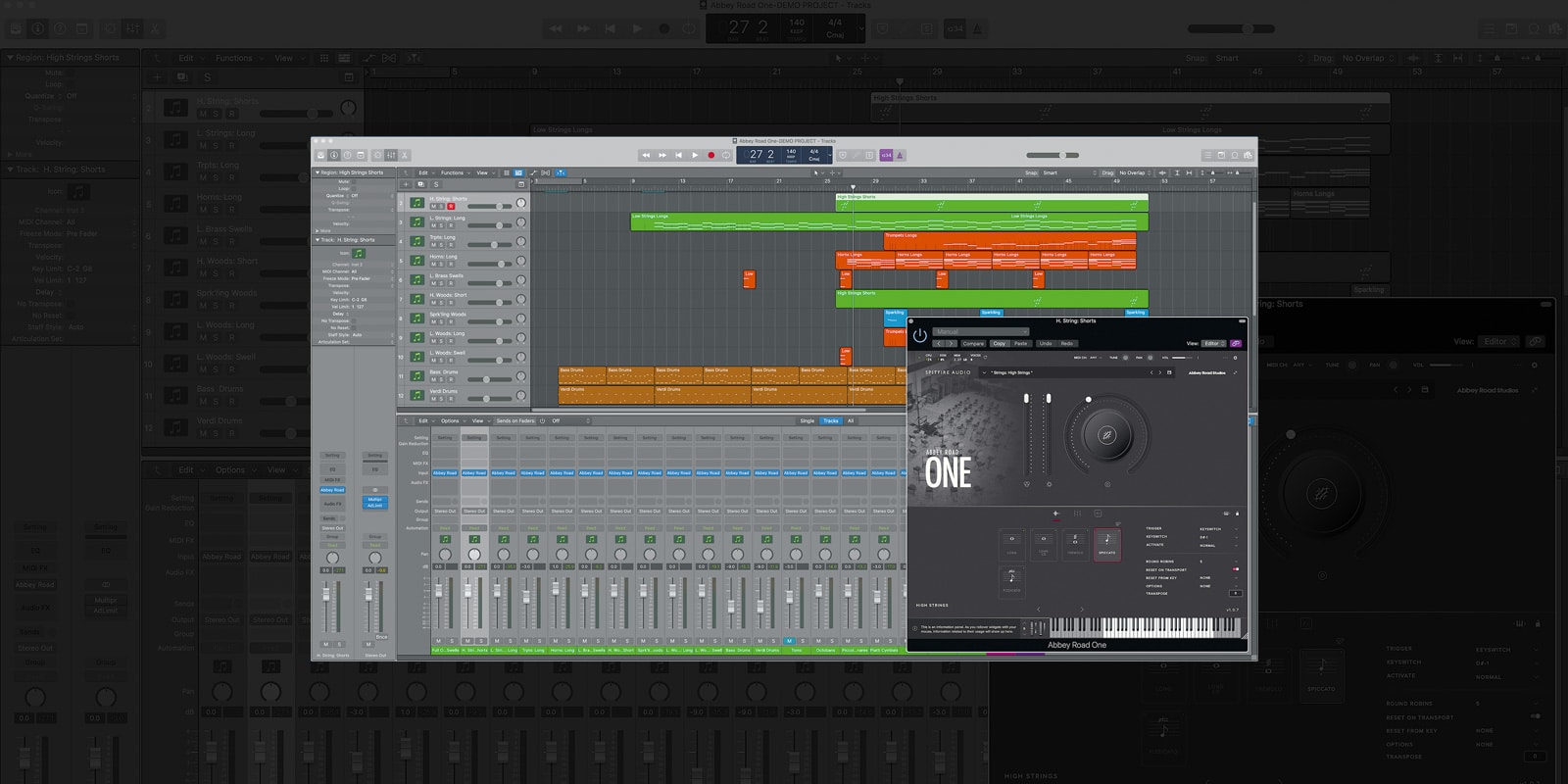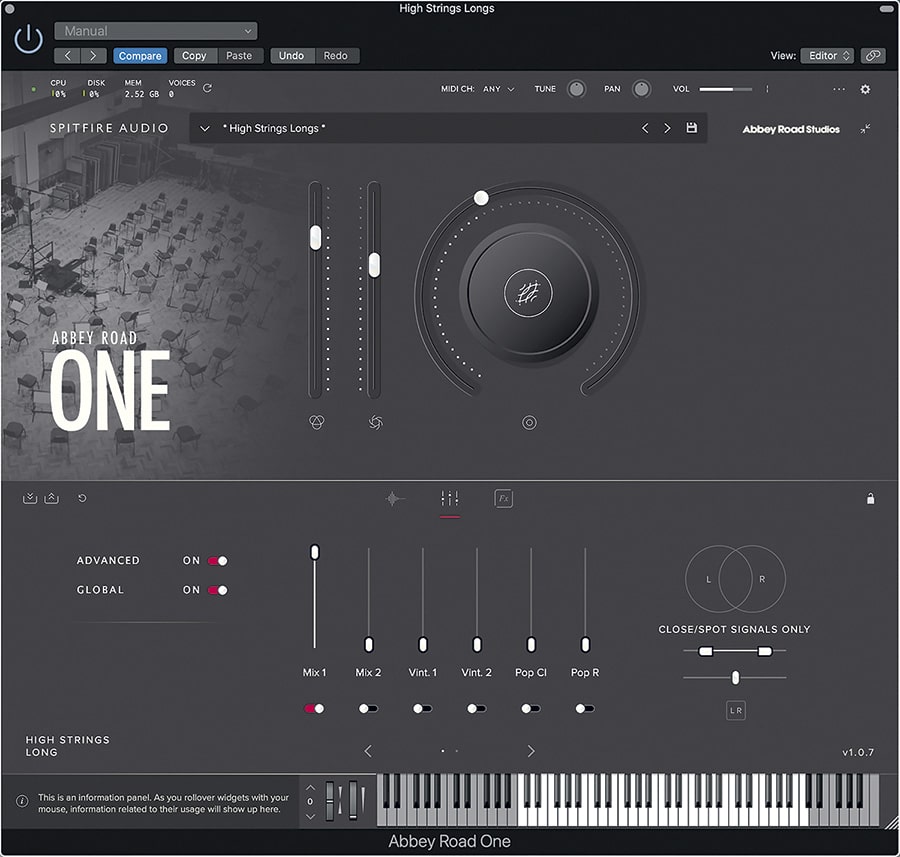Conduct the orchestra of your dreams, in one of the world’s most prestigious rooms
Review by John Czerwinski
Abbey Road One: Orchestral Foundations from Spitfire Audio is a sample library/virtual instrument designed for workflow efficiency. Musicians and composers can maximize their inspiration and work quickly—even novice orchestrators can now produce great-sounding tracks with minimal effort, and without getting bogged down in the intricacies of virtual orchestration.
The space
As the name implies, Abbey Road One (‘ARO’ moving forward) was recorded at the venerable Abbey Road Studio One in London. While Abbey Road will forever be synonymous with the Beatles, Studio One remains one of the most prized film scoring sound stages in the world. Its enormous size can accommodate the largest of ensembles and has a revered depth and warmth. The samples in ARO were authentically captured by an impressive arsenal of modern and vintage mics, from ten different positions.
Past Featured Reviews
- Focusrite Clarett+ 8 Pre
- Focusrite Scarlett Solo & Scarlett 18i20 / Hitmaker Expansion Bundle
- Review: Focal Alpha 80 Evo
- December 2021: Genelec 8361A
- November 2021: RME Fireface UCX II 40-channel USB Interface
- Focal Alpha 65 Evo
- Hit’n’Mix RipX: DeepAudio
- October 2021: Slate Digital FG-2A and Custom Opto
- September 2021: KRK Classic 7
- Merging Technologies MERGING+ANUBIS Music Mission
- August 2021: Overloud TH-U Premium
- July 2021: IK Multimedia Total Studio 3 MAX
An organized blend
The library organization is similar to the Spitfire Albion One offering, in that groups of instruments—strings, brass, woodwinds, and percussion—are organized and pre-blended together. If you prefer specific or unusual pairings, the Spitfire BBC Orchestra may be a more appealing option. With that said, ARO offers splendidly blended combinations of orchestra sections that sound amazing right out of the box.
Upon opening the dedicated player in your DAW (Logic in my case), the initial patch is an elegantly balanced and dynamic mixture of the entire orchestra playing at once, complete with staccatos and swells—perfect for an epic, full sound. The real delight though, comes when digging into the individual sections.
Strings
Thirty violins and twelve violas comprise the high strings, while ten cellos and eight basses make up the low strings. Both sections are rich in tone, warm in color, and transition smoothly through all of the dynamic layers. Included articulations comprise vibrant spiccatos (a detached style of playing where the bow bounces off the string), delicate pizzicatos (plucking the string rather than using the bow), energetic tremolos, and con sordino (where a mute is applied to soften and alter the tone for quiet passages). I’m a bit picky when it comes to high strings not sounding thin and tinny, and ARO does not disappoint. Five round robins are included, achieving an incredible amount of realism when playing spiccato passages. Unlike Albion and BBC, ARO omits a legato articulation, but perhaps this will be offered in an upcoming module.
Woodwinds
If strings provide the foundation for the orchestra, the winds are the next crucial structural block. They have the strongest relationship with the string section and provide a liaison of sorts with the brass. Like the strings, ARO splits them into high and low sections, ideal for expressing the range from light and frivolous to melancholy and moody. Though the long passages are supple and smooth, I found the most enjoyment from playing staccato and building light, rhythmic passages as a foundational element for creating anticipation and energy.
Brass
Brass is organized into three sections: high brass, horns, and low brass. The brass section comprises four trumpets, four French horns, three trombones, two bass trombones, a contrabass trombone, a tuba, and a contrabass tuba. As with the strings and woodwinds, these meticulously detailed sections can produce an astonishing dynamic range. It was hard not to find myself distracted by reproducing some excerpts from Brahms and Mahler! The included articulations are the most often utilized: staccato, tenuto, and marcato. I was perhaps most taken by the three varied-length versions of swells included in the library; they are perfect for accenting points in the work without having to build them from scratch.
Percussion
The percussion section’s fourteen instruments provide all the tumultuous booming, crashing, cracking and ringing one would want for orchestral support. The powerful bass and Verdi drums and toms have an enormous weight and depth, while the snares, particularly the piccolos, have that wonderfully pleasing midrange crack and snap. The metal patch includes a full selection of splashes, crashes, chokes, and swells, as well as a beautifully rich tam-tam and anvil. Glockenspiel, xylophone, and timpani round out the tuned percussion, all of which highlight the incredibly captured acoustics of Studio One.
Mic Mixes
A superb group of musicians in a great-sounding room will only sound as good as the mics with which they are captured, and this is where the library shines. As mentioned, Spitfire used ten mic positions and a combination of vintage and modern mics, including a pair of one-of-a-kind RM1B mics in the Abbey Road locker, to provide an almost limitless amount of possibilities for sonic customization.
Simon Rhodes, currently the Sr. Engineer at Abbey Road, created two stereo mixes for an epic sound right out of the box. The default setting (Mix 1) provides an immediate and full cinematic mix, while Mix 2 offers a bit more immediacy. Need more of a pop mix? Use the pop close mics and dial in some of the ambient or outrigger mics to taste!
A symphony of orchestral choices
After releasing its acclaimed BBC Symphony Orchestra library about a year ago, one would be hard pressed to cast criticism if Spitfire had opted for some respite before issuing a follow-up library of this caliber. And yet, Spitfire has done just that.
Comparisons are likely to be made between Albion One, BBC Symphony Orchestra, and Abbey Road One. Of course, a big difference is the varied sound of the rooms. To my ears, ARO is the most pleasing of the three. The room’s openness and size are readily apparent while also offering the most options for mic mixes. BBC SO has the most flexibility of instrumentation in that it provides individual sections, while Albion One has the most articulations as of this writing. In terms of dynamic layers, Albion One has up to three, BBC SO has four, and ARO has up to seven, making it the most expressive of the three. Albion One offers a selection of synths and loops that the other two do not, which some modern orchestrators might find appealing. I could go on, but suffice to say, I applaud Spitfire in creating diverse packages that offer choices to the end user.
One practical note: Abbey Road One requires 70GB of disk space.
Sparkling Woodwinds and Legendary Low Strings
Spitfire has also just announced two additional smaller film scoring modules that will work in ABO (or independently) and expand the library’s palette ($49 each). I was able to get a sneak peek of ‘Sparkling Woodwinds’, an excellent layering of woodwinds and tuned percussion, and ‘Legendary Low Strings’, which offers a beautiful octave version of the low strings. Both incorporate legato, long, and staccato phrasing for additional polish and shine.
Holy Buckets!
Every once in a while, a sample library comes along that elicits an out-loud response from me, and that was my initial reaction upon trying Abbey Road One: Orchestral Foundations from Spitfire Audio. It’s getting even better the more I dig in.
Price: $449 (MSR)
More From: spitfireaudio.com



